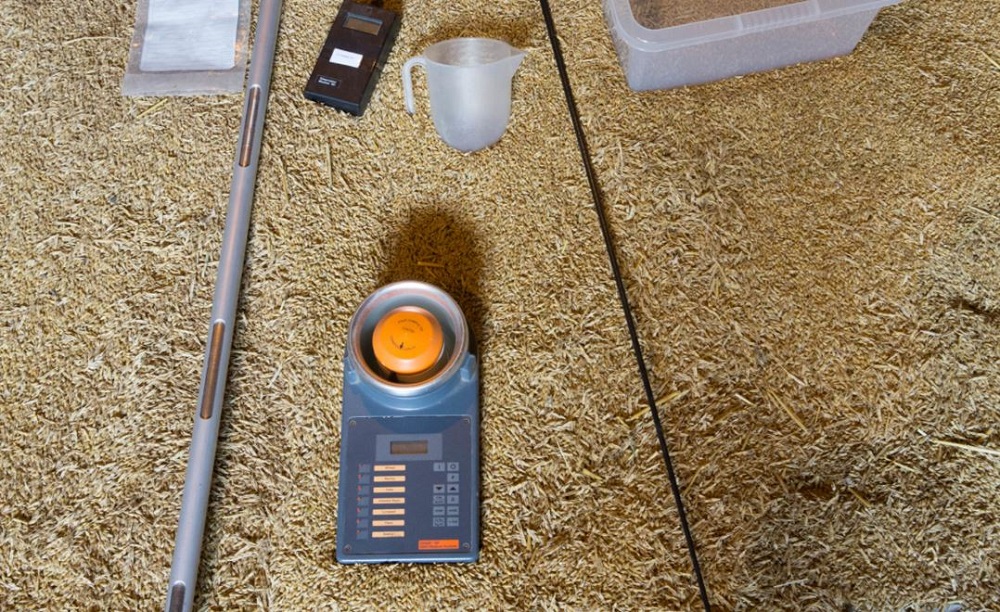- Home
- Knowledge library
- How to sample grain
How to sample grain
If taken and stored correctly, grain samples provide a powerful record of grain quality. Central to success is the segregation of different grain qualities, and the extraction of representative samples with the appropriate equipment.
An introduction to grain sampling
The best approach to grain sampling depends on the sampling point (e.g. at harvest, in store, outloading and intake). However, there are three broad sampling stages used to build a final sample, suitable for a wide range of analyses.
Note: Mycotoxin tests require a particularly demanding sampling regime – especially for the storage mycotoxin, ochratoxin A (10 kg sample required).
Stage 1. Take incremental samples
An incremental sample is any single, relatively small sample that is combined with others. This sample may be taken by spear, jug or other means. They are taken at one point in the grain chain, from grain with similar qualities.
Stage 2. Create an aggregate sample
Incremental samples, taken in Step 1, are combined to form a large aggregate sample. These should be held in a clean dustbin or similar container.
Aggregate samples include grains of various sizes and quality. It is important that all grains have an equal chance of being included in any subsample drawn from it – so that it is truly ‘representative’. This requires a thorough pre-mixing of the sample, with a drum mixer or by hand.
How to mix aggregate samples with a drum mixer
- Do not fill drum mixers more than half full
- Secure contents with a tight-fitting lid
- Roll the drum along its axis
- Invert drum at least five times
How to mix aggregate samples by hand
- Tip the aggregate onto a clean floor area
- Mix thoroughly with a shovel/scoop
Stage 3. Make representative samples
A thoroughly pre-mixed aggregate sample can be used as the source for representative subsamples. Such samples are most suitable for laboratory analysis. The extraction of subsamples requires further mixing of the grain. There are several methods (of varying complexity) that produce optimally mixed grain. A simple method is coning and quartering.
The coning and quartering method
- A heap of tipped grain will take the rough form of a cone – it can be described as having four quarters (e.g. A, B, C and D).
- Select two opposite corners (e.g. A+D). Remove the other two quarters (e.g. B+C) and return them to the original aggregate container.
- Mix the selected samples (e.g. A+D) again to form a new cone of grain.
- Repeat until the size of one of the quarters is the equivalent weight of the final sample required (e.g. 1 kg).
.png) AHDB
AHDB
Other methods
In addition to 'coning and quartering', other methods use dividers, such as a cone-shaped divider, a rotary mechanical divider or a riffle divider. Details for using such equipment are given in ISO 24333.
Note: Do not use riffle dividers for samples of less than 2 kg.
Grain sampling equipment
Ahead of harvest, ensure that all equipment is maintained (e.g. serviced and calibrated), clean and ready for use.
Sampling equipment includes:
- Sampling spears*
- Measuring jugs
- Weighing devices
- Sealable** plastic sample bags (1 kg grain capacity)
- Sealable** containers (5–10 kg grain capacity)
- Suitable labels (to apply to bags*** and containers)
- Indelible pens (ballpoint ink may fade in a matter of months)
- Moisture meters
- Record sheets
- Temperature probes (consider using automated systems)
- Insect traps
*Notes on samplers
A single chamber sampler (or ‘deep bin probe’ or ‘Neate sampler’) collects one primary sample at a time. If the depth of grain in the bulk is greater than the length of the sampler, use screw-on extensions. A multi-chamber sampler usually has three or more chambers. Seed collected in a single sampling action constitutes one primary sample. Suitable for most trailers, use it to sample grain up to 2 m deep. A piece of plastic guttering is useful for collecting samples from this type of sampler.
Other notes
**Seal containers to minimise moisture loss, prevent rodent access and avoid contamination by dust and other grain.
***Specialist sample bags feature white printed writing strips.
General grain storage safety
There are a number of health and safety issues to consider when handling grain and working in stores:
- Ensure appropriate training is given and those involved in sampling are aware of the risks
- Make sure equipment is suitable for purpose and has been checked to ensure fitness for use
- Check staff and visitors are aware of the vehicular movements
- Wear hi-vis clothing when working around loading lorries
- Do not climb on top of lorries, unless there is special provision
- Ensure people sampling from a grain bulk are accompanied
- Minimise exposure to grain dust
- Never enter a closed silo
 Tim Scrivener
Tim Scrivener

